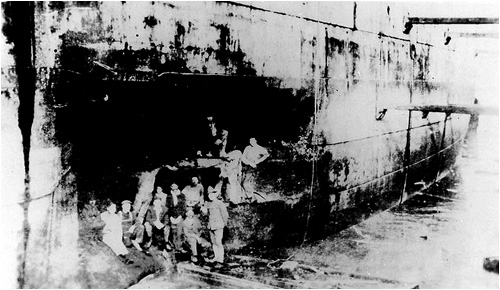| Before any troop transportation could be undertaken, all of the ships had to be hastily refitted—in two weeks in the case of Finland.
Of the fourteen ships, ten, including Finland, were designated to carry human passengers; the other four were designated as animal ships.
The ten ships designated to carry troops had to have all of their second- and third-class accommodations ripped out and replaced with berths for troops.
Cooking and toilet facilities had to be greatly expanded to handle the large numbers of men aboard.
Finland, uniquely among the fourteen ships, already carried guns and did not need to be refitted for them.
All the ships were manned by merchant officers and crews but carried two U.S. Navy officers, Navy gun crews, quartermasters, signalmen, and wireless operators.
The senior Navy officer on board would take control if a ship came under attack.
The American convoy carrying the AEF was broken into four groups.
Finland was in the third group with San Jacinto and Henry R. Mallory, and escorts consisting of cruiser Charleston, armed collier Cyclops, and destroyers Allen, Preston, and McCall.
The headquarters detachment and six companies (of a total of 12) of the 18th Infantry Regiment embarked on Finland at New York.
The ship, under the command of U.S. Navy Commander S. V. Graham, departed with her group on 14 June for Brest, France, steaming at a comfortable 13-knot (24 km/h) pace.
A thwarted submarine attack on the first convoy group,and reports of heavy submarine activity off of Brest resulted in a change in the convoy's destination to Saint-Nazaire.
After returning to the United States, Finland 's next convoy crossing began on 6 August in the company of Henderson, Antilles, and San Jacinto, all escorted by cruiser Montana.
Finland, carrying some of the troops that had tried to depart on 30 July on Saratoga before she sank near Staten Island,had an uneventful roundtrip.
Finland next sailed on 24 September as part of the 8th convoy with Henderson, Antilles, and Lenape, escorted by cruiser San Diego.
According to Crowell and Wilson, the 8th group was "destined to misfortune".
Three days out from New York, Lenape developed engine trouble and was compelled to return to port, but the rest of the convoy proceeded on and arrived in France on 7 October.
Henderson was the only ship to return to the United States without incident.

Workers pose by the torpedo damage to Finland in drydock at Brest, France.
Finland began her return journey to the United States on 28 October in an 11-knot (20 km/h) convoy with cargo ships Buford and City of Savannah and escorted by armed yachts Alcedo, Corsair, and Wakiva II, and destroyers Smith, Lamson, Preston, and Flusser.[34] Finland, reurning most of the survivors of Antilles back to the U.S., was struck on her starboard side by a torpedo from U-93 at 09:27, 150 nautical miles (280 km) from the French coast.[34][35] Many of the civilian crew and the survivors of Antilles, experiencing a torpedo attack for the second time in 11 days, panicked. Lifeboats were immediately launched without word from Commander Graham, and the engine room and fire room men all left their stations, contrary to orders. The naval officers, armed with a revolver and a wooden mallet, were able to get the men back to their stations. The damage was limited to one cargo hold and had not affected the boilers or the engines. Although Finland took a starboard list, it did not increase and Graham was able to steer a course back to Brest, anchoring there the next morning. Men aboard the prematurely launched lifeboats were rounded up by Wakiva II and Alcedo and returned to Brest.[34] Nine men,[36] including three of the Naval Armed Guard detachment,[37] perished in the attack.
In the aftermath of the torpedoing incident, Commander Graham was awarded the Navy Distinguished Service Medal for his "exceptionally meritorious service" in getting Finland safely back to port.[38] Lieutenant (junior grade) Huntington English, from Wakiva II, received the Navy Cross, in part because he rescued a soldier who had jumped from the torpedoed transport.[39] Chief Boatswain's Mate John P. Doyle, on Alcedo, was issued a letter of commendation for commanding a whaleboat that pulled a number of men from Finland from the water.[40]
The deportment of the crew aboard Finland, as well as that of Antilles, while under attack demonstrated the problems with civilian-manned vessels. The Navy, led by the recommendations of Rear Admiral Albert Gleaves, insisted that all troop transports be manned entirely by Navy personnel. This was accomplished soon after so as to avoid the need for what Gleaves called "ignorant and unreliable men" who were "the sweepings of the docks".[34]
Finland was sufficiently repaired over the next two months and sailed for return to the United States on 5 January 1918.[28] Ready again for convoy duty the next month, she sailed from New York on 10 February with Antigone, Martha Washington, President Lincoln, and Von Steuben under escort of the cruiser Pueblo.[41] After safely reaching Saint-Nazaire, Finland discharged her passengers and cargo that included 13,910 pounds (6,310 kg) of frozen beef for the AEF.[42] On 27 February, one day after departing, Finland 's steering gear jammed, forcing her into the path of Henderson. That ship was able to maneuver such that Finland only dealt her a glancing blow. Finland suffered only superficial damage; Henderson was holed below the waterline, but her crew took advantage of unusually calm February seas to repair the damage, and were soon able to proceed to New York.[43] Finland and President Lincoln arrived back at New York on 16 March.[41]
Finland made one more crossing under Army charter. Leaving New York on 23 March, she convoyed with Powhatan, El Occidente, Martha Washington, and cruiser Pueblo, arriving in France on 4 April. Finland returned to New York on 24 April,[44] and was delivered to the U.S. Navy the same day.[45]
|